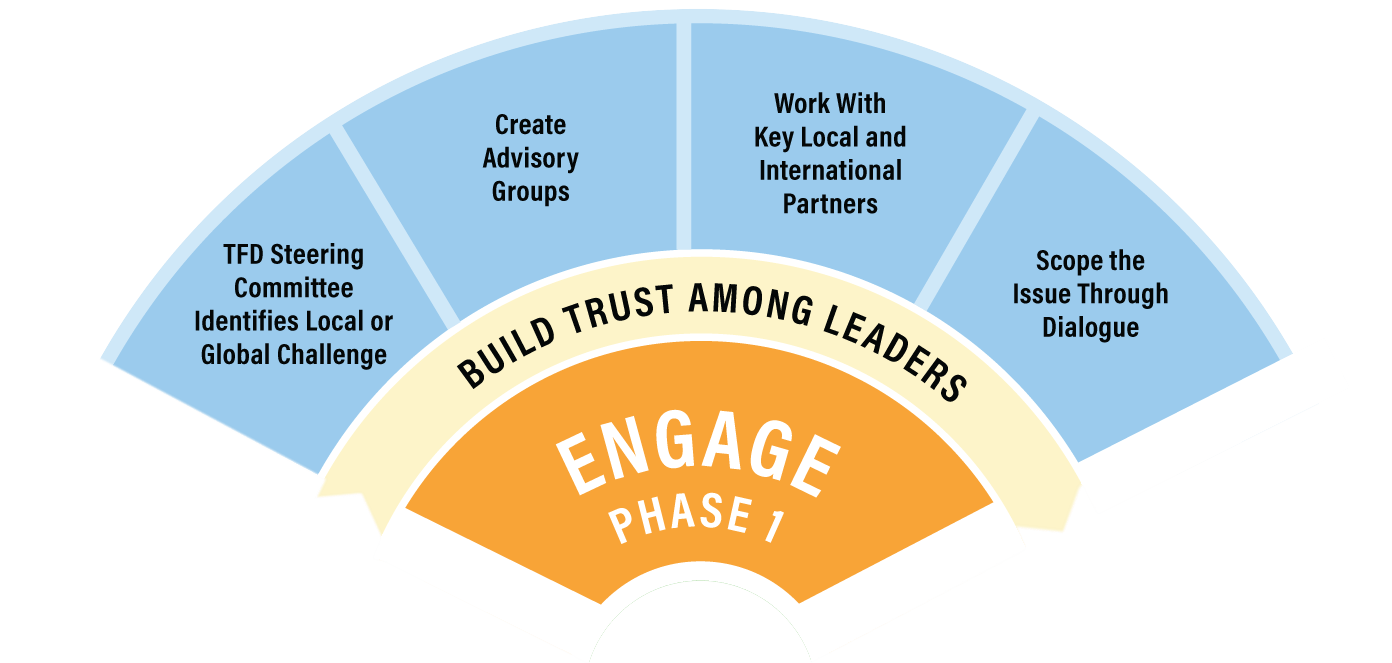Build Trust Among Leaders
Build Trust Among Leaders

The core objective of Phase One is to build trust between leaders of the initiative, who represent different stakeholder groups and different interests. Trust is often the glue that sustains participants’ relationships with one another. These relationships are key to the durability and success of a dialogue.
TFD Steering Committee Identifies Local or Global Challenge:
The dialogue process begins with a SC member or members proposing an issue, and corresponding fracture lines, that need solving. These issues are often ones that their organizations or partners on the ground face regarding forests and livelihoods. This often occurs through formal presentations or informal conversation during the annual SC meeting.
If the SC is interested in the idea, one SC member will draft a concept note that explains and justifies how the proposed challenge would benefit from a TFD initiative. The SC as a collective then reviews the concept note and the topic based on a set of standard criteria:
- The issue’s significance and priority relative to TFD’s purpose, mission, and goal
- The dialogue’s potential—based on information available, willingness of stakeholders to engage, existing analysis, and clear possibilities to achieve impact and change
- Comparative advantage of TFD on the issues and in possible locations
- Indication of interest from local partners and country offices of Steering Committee members’ organizations
- Likely ability of local, regional, and global partners to reach and engage stakeholders
- Availability of financial and logistical support
While evaluating an issue, the Steering Committee will also review the full suite of current initiatives to ensure balance across geography, content matter, and stakeholder engagement.
Create Advisory Group:
Successful dialogue initiatives need a way to ensure effective and varied representation of stakeholder perspectives, build credibility, and maintain neutrality. In the TFD governance structure, this group is referred to as the Initiative Advisory Group (or “Advisory Group”).
Work with Key Local and International Partners:
Once the Advisory Group has been formed, the next step is to work with key local and international partners to analyze the situation, map stakeholders, and develop buy-in for the initiative. In TFD’s model the researcher conducting the analysis is often a member of the Advisory Group, a commissioned researcher or consultant, or an in-house staff member. The output of this research is a Scoping Paper that outlines the context of the issue and the ways in which dialogue can be useful for moving toward solutions. The research analyzes the issue’s dimensions, the state of understanding and response, stakeholders involved, and critical tensions that can be addressed through dialogue. The analysis explores formal and informal structures that have facilitated the current situation and examines which structures are impeding solutions. Through the process, the researcher will identify countries that could provide effective case studies of the issue. These are explored later in the process to determine feasibility and appropriateness for hosting a dialogue. The researcher will have produced a list of potential stakeholders. The Advisory Group additionally discusses this list and adds or modifies with additional stakeholders as needed. This list may also form the initial draft of a participants list for the dialogues. At this stage, the Advisory Group begins to approach these stakeholders to gather input, discuss the issue, and pave the way for future involvement.
Scope the Issue Through Dialogue:
Together, the Scoping Paper and the Advisory Group lay a strong foundation for the beginning of an initiative. However, these outputs are the products of a relatively small group of people. Before entering Phase Two, it is critical to create resonance for the initiative with a larger and more representative group of stakeholders. Expanding the group of stakeholders also helps to refine the concept, focus attention, and clarify the context and fracture lines. TFD often achieves these goals through Scoping Dialogues. A TFD Scoping Dialogue is usually the first multi-stakeholder dialogue in an initiative. Typical objectives of a Scoping Dialogue include understanding an issue’s fracture lines, information gaps, and the role (or lack thereof) of dialogue in addressing the issue. These dialogues orient the initiative, build trust for future dialogues, and improve understanding of the issue. At this early stage, they do not seek solutions. Following the Scoping Dialogue, the co-chairs, with the support of the Secretariat, produce a Co-chairs’ Summary Report, capturing the key perspectives, discussions, agreements, and next steps from the dialogue. The Advisory Group and SC review the Scoping Dialogue’s outputs and create a tentative plan for the initiative. This may include dialogues in specific countries to explore country-level scenarios or it may include more globally focused dialogues.
See the TFD guide for further details on the Phase 1 of the TFD process
